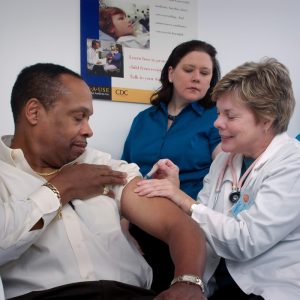Blog
Just a few weeks after American Medical Association (AMA) President Jesse M. Ehrenfeld, MD, MPH, publicly called out his growing concern about a national physician shortage and the worrying state of the American healthcare system, the validation of his fears came through loudly and clearly in news reports about a healthcare mega-merger.
In late November, both Reuters and The Wall Street Journal, reported that health insurers Cigna and Humana were in talks to merge and create what would be “a new powerhouse in the health-insurance industry.” While Cigna called off its pursuit of Humana about a week later and said instead it will focus on a big stock buyback, the emphasis on financial returns over patient care in healthcare remains the same.
The potential consolidation of insurers or other healthcare businesses is just one of several “critical strains on physicians” that add to a list of challenges that includes a broken Medicare payment system and enormous administrative burdens, Dr. Ehrenfeld said at the National Press Club.
He added, “Physicians everywhere—across every state and specialty—continue to carry tremendous burdens that have us frustrated, burned out, abandoning hope … and in increasingly worrying numbers, turning our backs on the profession we’ve dedicated our lives to.” (This phenomenon of physician dissatisfaction has been discussed in our Medicine in America podcast interviews.)
A Cigna/Humana merger would have created a new company that rivaled in size UnitedHealth Group and CVS Health. It also would have ratched up the pressure and upheaval now standard in the provider-payer environment.
A little history is important here for context. Back in 2016, the Department of Justice sued to block the proposed acquisition of Cigna by Anthem and a separate deal between Humana and Aetna. DOJ alleged that the transactions – both of which failed to be completed – would harm individuals, employers, doctors and other providers “by limiting price competition, reducing benefits, decreasing incentives to provide innovative wellness programs and lowering the quality of care.”

Today, the same fears about consolidation of insurers are being expressed.
“A merger between Cigna and Humana could ultimately be anticompetitive for smaller players — but it could also be a catalyst for further consolidation,” Advisory Board said in its daily briefing newsletter. “In most cases, consolidation does not equal better prices or more options.”
At Medicine in America, one of our goals is to track these changes across the healthcare landscape and to highlight the new models of care that are emerging and the physician entrepreneurs who are leading the way into the future of healthcare.
Listen to a recent episode to hear how Lauren LaCute, DO, and Kim Lynch, CEO/Founder of Metis Health, are working on ways for “Reinventing Family Medicine with a Data-Driven, Value-Focused Medical Model.” https://medicineinamerica.org/2023/08/03/reinventing-family-medicine-with-a-data-driven-value-focused-medical-model/
Dr. LaCute made the jump from a hospital-owned academic practice where revenue targets were increasingly rigorous and “everything about medicine was rushed” to her own private practice specializing in family medicine.
Mark Tosh
**** **** **** **** ****

In healthcare today, this much we know is true: The status quo is unsustainable.
And the facet of healthcare seeing the most change today is traditional primary care, which is getting battered routinely by the moves of big digital tech companies, and others, working to change the rules of healthcare for both providers and patients.
Indeed, this month Amazon announced a primary care service as a new feature of Prime membership. Amazon now provides access to primary care services for $9 monthly through its One Medical healthcare platform.
One Medical provides access to 24/7 virtual and expedited care for things such as cold symptoms, as well as same- or next-day remote or in-person appointments at One Medical primary care offices. Virtual care users will not have any additional costs, as the entire service is included in the membership fee.
Primary Care Model Seen as Unsustainable
Even as new entrants delve into healthcare delivery, many physicians are weary of being forced to see more patients in less time today – as discussed in our Medicine in America podcast interviews. These doctors also have less autonomy in clinical decision-making as corporations and other investors take over running their hospital or practice. As a result, HCPs are exploring new innovative practice models and career changes.
Yet, while the pipeline of new doctors joining the profession is strong, the ranks of doctors is “just not rising fast enough” to meet future demand in the U.S., according to the American Medical Association (AMA).1 This is why burnout – and other issues – are aggravating the physician workforce shortage.
A 2021 report published by the Association of American Medical Colleges estimates the U.S. will be short as many as 48,000 primary care physicians by 2034, a higher number than any other single medical specialty.2
In addition, a 2022 AMA survey of 11,000 doctors and medical professionals found more than one-half reported feeling burned out and experiencing great stress.
New Models of Primary Care Emerge
As concerns about the sustainability of the U.S. primary care system grow, an era of innovation is emerging in response to both the challenges and the opportunities in the field, according to NEJM’s analysis. “Numerous new models of primary care financing and delivery are rapidly arising throughout the country, and some see this as a possible savior for primary care. But, in many ways, these changes could either fail to meet the hype around them, or in some cases even hasten the end of the independent primary care practices that once dominated the physician landscape.” 3
It’s also important to watch and consider how innovation and new models of primary care might further challenge the viability of traditional independent primary care practices that once dominated the physician landscape, NEJM noted.
At Medicine in America, one of our goals is to track these changes and to highlight the new models of care that are emerging and the physician entrepreneurs who are leading the way into the future of healthcare. Listen to the latest episode to hear from a Family Nurse Practitioner, Spring Lane, who launched her own subscription-based wellness practice and plans to franchise it across the country.
Mark Tosh
- “Burnout threatens primary care workforce and doctors’ mental health.” — Author: Lauren Sausser, KFF Health News. CBS News Health Watch, June 7, 2023.
- “AAMC Report Reinforces Mounting Physician Shortage.” Press release, June 11, 2021.
- “Making Sense of New Approaches to Primary Care Delivery: A Typology of Innovations in Primary Care.” – Authors: Bruce E. Landon, MD, MBA, MSc, Gabe Weinreb, BA, and Asaf Bitton, MD, MPH. NEJM Catalyst, May 9, 2022.

Is it burnout or is it a shift in the way practices are being managed by major corporations and private equity owners?
We all are seeing article after article about physician burnout and how it’s causing staffing shortages and accelerating the rate of physicians looking for alternative careers or even just retiring from the medical profession. The other factor beside a pandemic that has brought major change to healthcare is the significant increase in private equity-backed acquisitions of hospitals and practices. According to public reports, private equity acquisitions of healthcare-related businesses have risen from an estimated annual deal value of $41.5 billion in 2010 to more than $200 billion in 2021. PE firms have pumped more than $750 billion into U.S. healthcare during the past 10 years.1
Nearly 70% of U.S. physicians now are employed by hospitals or corporations backed by private equity or health insurers, a new report finds. Almost seven in 10 U.S. physicians are now employed by hospitals or corporations like private equity firms and health insurers.2
This is due, in part, to the COVID-19 pandemic, which drove doctors away from independent practice.
It is clear from our Medicine in America podcast interviews during the past six months that physicians are being pressed to see more patients and they now have less autonomy in clinical decision-making as corporations are now running the hospital or practice. There’s no question COVID pushed HCPs to the limit, but corporate medicine is also a major factor in HCPs looking for alternative career tracks or starting their own practices.
This is not to say that corporate medicine hasn’t brought significant innovation and efficiencies to healthcare, but we have not determined its impact on HCP job satisfaction. Maximum Profit healthcare: will it leave us with fewer well-trained physicians and worse outcomes?
Sources:
- www.modernhealthcare.com/providers/nearly-70-us-physicians-now-employed-hospitals-or-corporations-report-finds
- www.fiercehealthcare.com/finance/industry-voices-private-equity-investment-healthcare-making-positive-impact-especially
